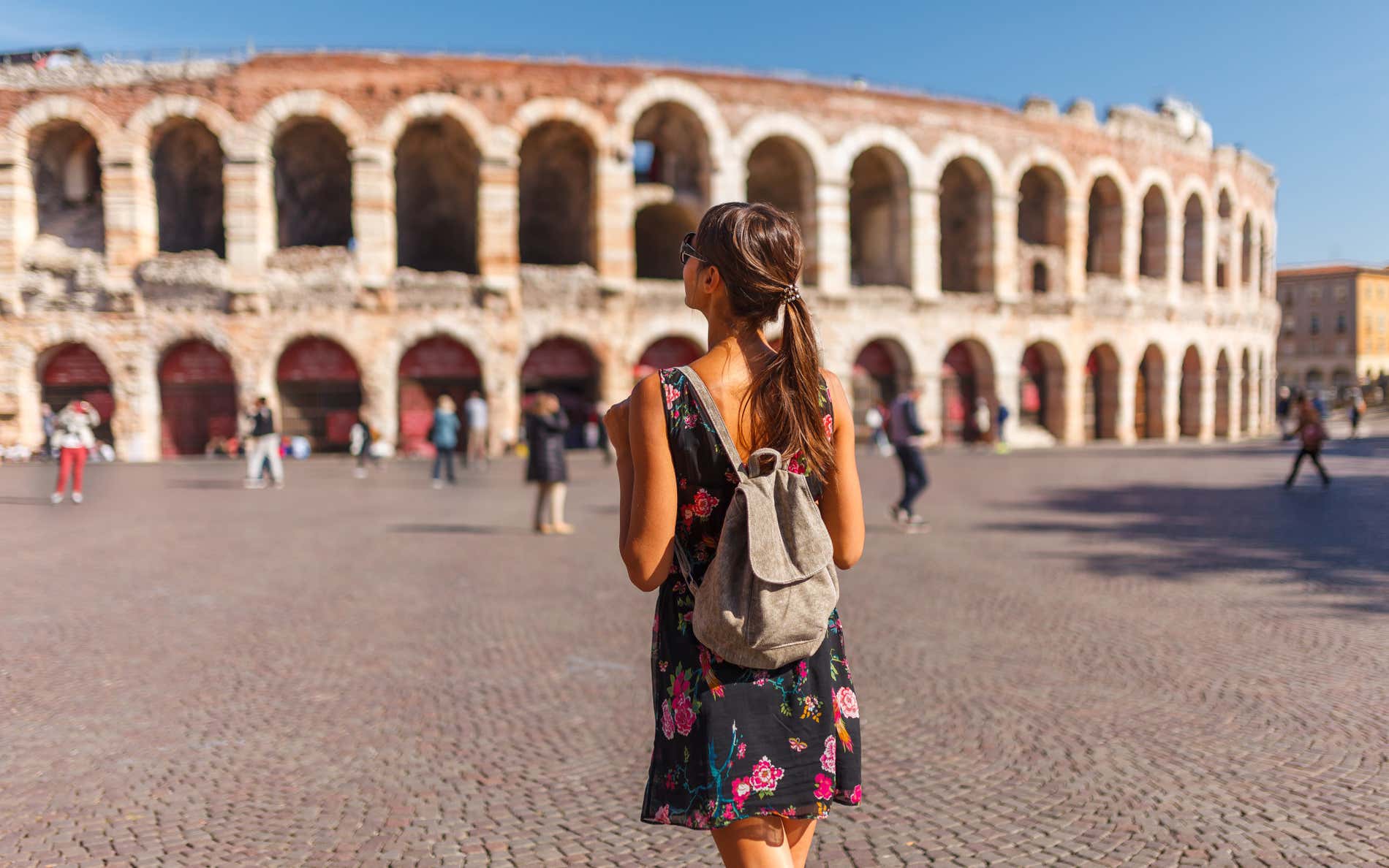Things to Do in Florence, the Cradle of the Renaissance
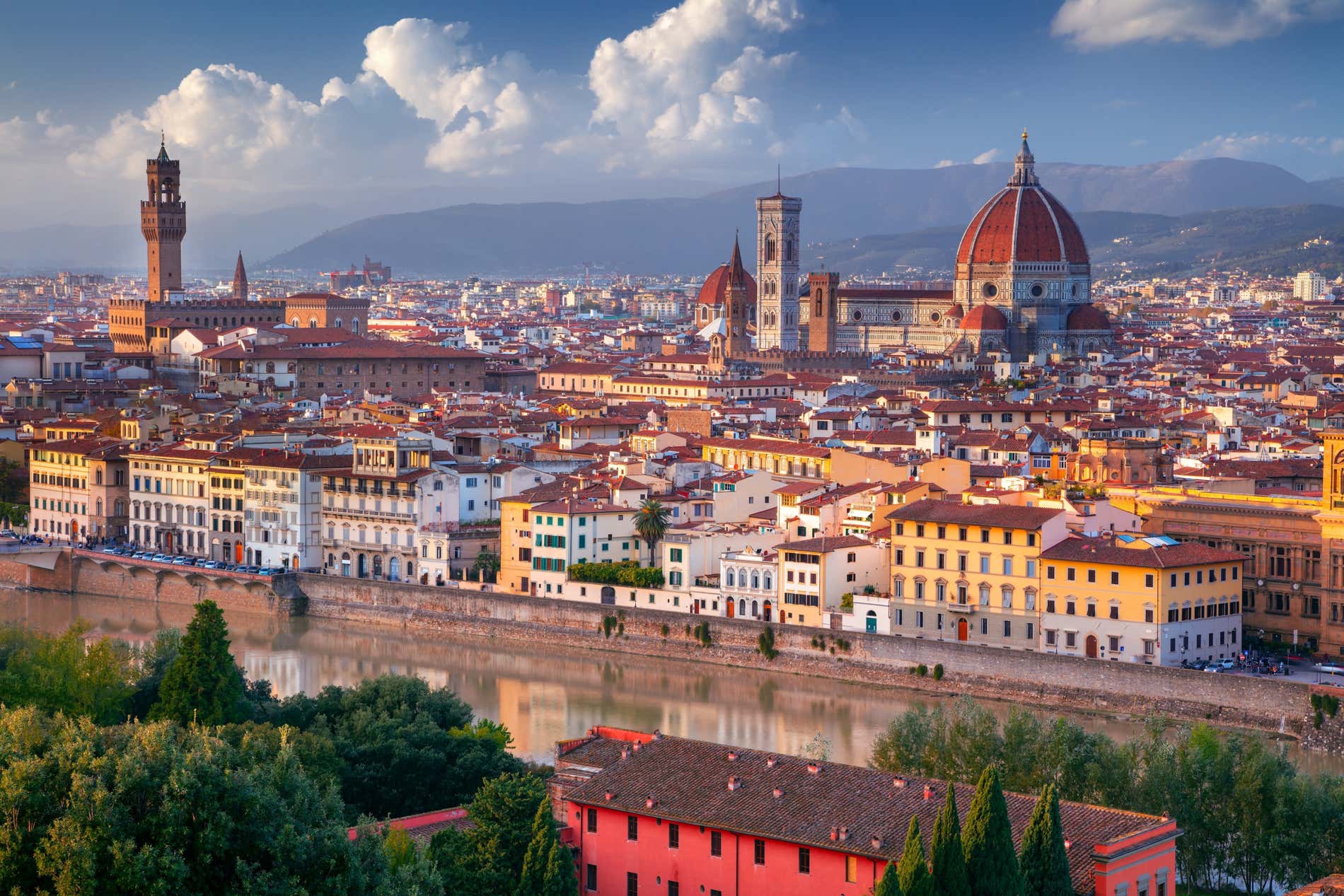
A city where legends like Michelangelo, Leonardo da Vinci, Galileo Galilei, and Dante Alighieri once walked the streets—that’s Florence! Thinking of visiting one of Italy’s most iconic cities and the birthplace of the Renaissance movement? You’ve come to the right place! Here at Civitatis, we’ll share all the must-see attractions and best things to do in the heart of Tuscany. Are you ready to explore this UNESCO World Heritage Site overflowing with art, culture, and history?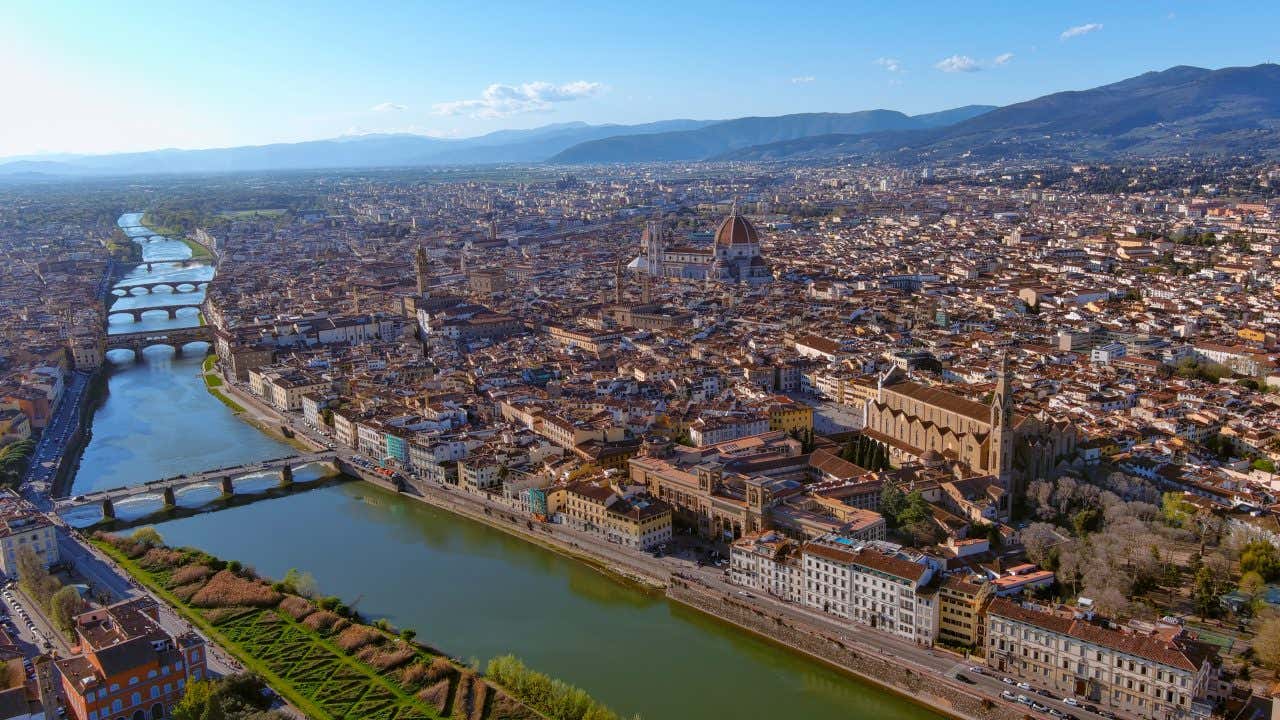
1. Visit the Stunning Florence Cathedral
Our list of things to do in Florence couldn’t begin in any other way than by visiting the Florence Cathedral, formally known as the Cathedral of Saint Mary of the Flower. This masterpiece of Gothic and Renaissance architecture is the city’s greatest icon. It’s considered one of the largest churches in the world, holding up to 20,000 people! Its construction began in 1296 and finished in 1436, after 140 years of dedicated craftsmanship.
Located in the Piazza del Duomo, the cathedral complex includes the Florence Baptistery and Giotto’s Campanile. The cathedral’s exterior, covered in marble panels in various shades of green, pink, and white, will surely amaze you. Inside, you’ll find 44 colorful stained glass windows depicting biblical scenes and saints, along with a large rose window representing the Virgin Mary. You’ll also see the colossal clock face with fresco portraits of four Prophets by Paolo Uccello from 1443. This clock is set in the 24 hours of the hora italica (Italian time), where the day ends with a sunset at 24 hours.
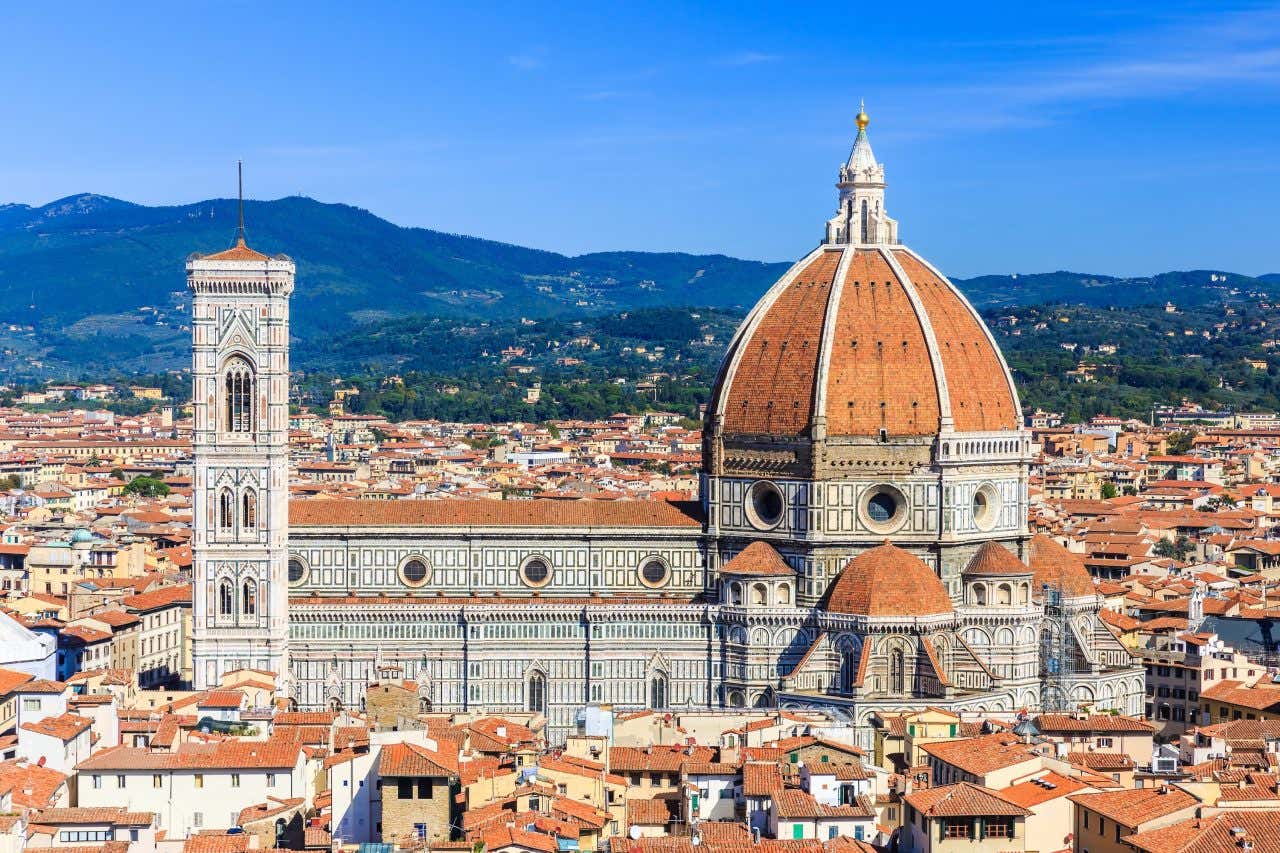
However, the Florence Cathedral’s main highlight is the spectacular Brunelleschi’s Dome, designed by Filippo Brunelleschi, an inspiration to many architects worldwide. With a diameter of 147 feet (45 meters), this massive dome is the largest brick dome ever built! Its innovative design was a groundbreaking achievement in architecture and engineering during the Renaissance. If you look at the dome’s ceiling, you can marvel at the giant fresco painting of The Last Judgment representing Christ, angels, and saints in dramatic scenes of salvation and damnation.
Check out this guided tour of the Florence Cathedral, where you’ll climb up to the terraces and enjoy the views of the city’s skyline while learning fascinating facts about this monument. Or, if you prefer to visit the cathedral and other emblematic monuments in the city, join this walking tour of Florence. To reach the top, you’ll have to conquer 463 steps—but we promise, the stunning scenic views are worth it!
2. Climb Up Giotto’s Campanile
Next to the Florence Cathedral stands its striking bell tower, Giotto’s Campanile, designed by architect Giotto di Bondone in 1334. Along with the Florence Cathedral and the Florence Baptistery, this monument is part of the UNESCO World Heritage Site covering the historic center of Florence. Together, these iconic landmarks form one of Tuscany’s most popular tourist attractions, drawing visitors from around the world.
This Gothic-style tower is adorned with white, green, and pink marble, mirroring the cathedral’s exterior. It features intricate low reliefs and sculptures representing scenes from the Bible, allegories of the planets, virtues, and arts.
At almost 280 feet (85 meters) tall, Giotto’s Campanile has 424 steps leading to the top, where you’ll have views of the Arno River, the Brunelleschi Dome up close, and the stunning Tuscan hills in the background. It’s divided into five distinct levels with detailed decorations, making it one of Italy’s most beautiful bell towers.
Did you know that it has seven bells and that each one has a unique name and purpose? Book this guided tour of Florence to see Giotto’s Campanile and learn about the impact of the famous Medici family on the city’s architecture. On the previously mentioned guided tour of the Florence Cathedral, you’ll also enjoy a 72-hour ticket for Giotto’s Campanile. It’s a must in Florence!
3. Immerse Yourself in Art in the Uffizi Gallery
One of the most important and famous art museums in the world is the Galleria degli Uffizi or Uffizi Gallery. This art museum is in the historic center of Florence, right next to the Arno River and the Ponte Vecchio. It was built in 1560 by Giorgio Vasari under the commission of Cosimo I de’ Medici and was originally designed as administrative offices (uffizi means “offices” in Italian). Over time, the Medici family transformed it into a space for displaying their vast art collection. In 1769, it was officially opened to the public as a museum.
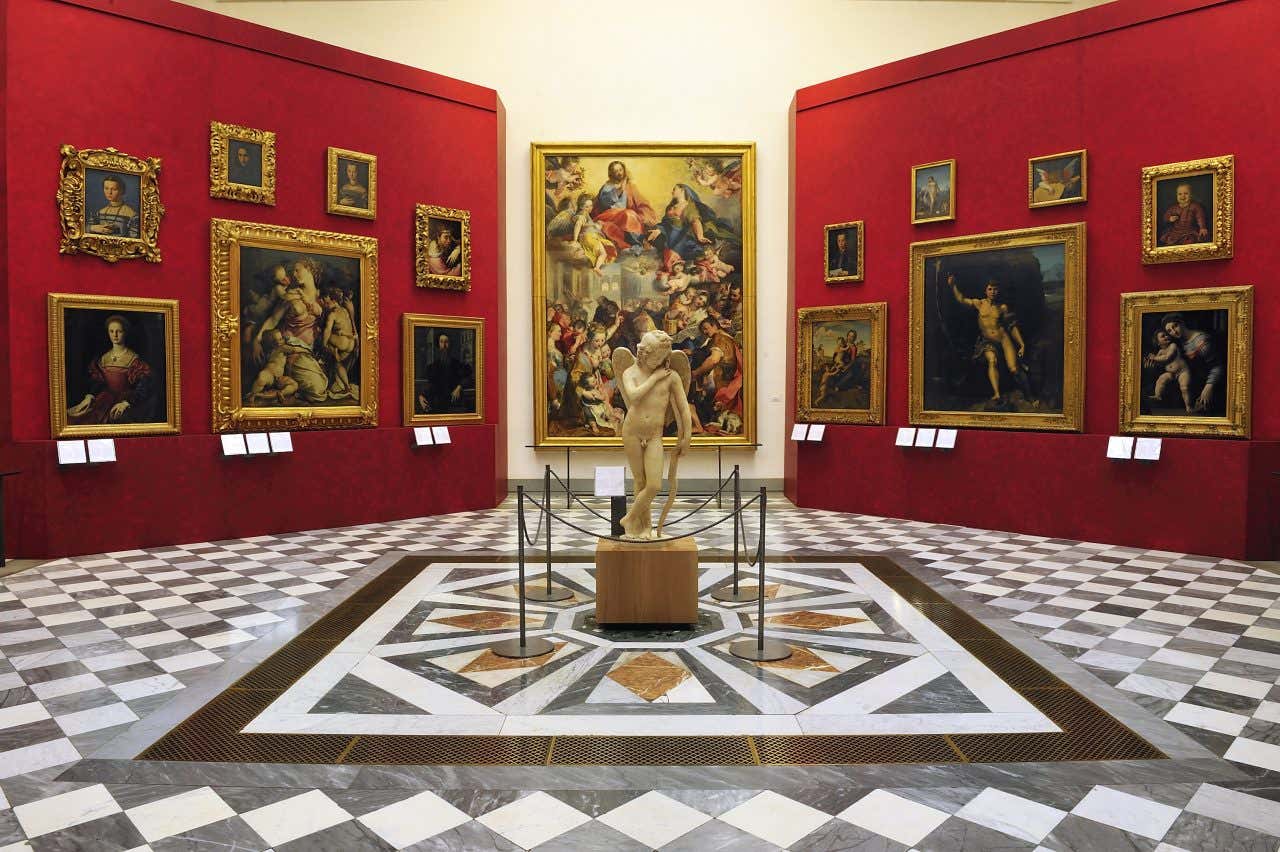
The Uffizi Gallery is home to an extraordinary collection of paintings, sculptures, and ancient artifacts from the Italian Renaissance. Here, you’ll find renowned artworks such as the Annunciation and The Adoration of the Magi by Leonardo da Vinci, Tondo Doni by Michelangelo, Bacchus by Caravaggio, and The Birth of Venus and Primavera by Sandro Botticelli. You can also see works by Raphael, Rembrandt, and many more.
Ready to explore one of the largest museums not only in Italy but in the world? Uncover the rich history of Florentine art with an expert guide by booking this tour of the Uffizi Gallery. You’ll get to skip the lines, too!
4. Discover the Florence Baptistery
The Florence Baptistery is located in front of the Florence Cathedral, standing in both the Piazza del Duomo and the Piazza San Giovanni. It dates back to the 11th century, combining Romanesque and Byzantine architecture. Dedicated to the patron saint of the city, John the Baptist, this site has been where many Florentines were baptized, including important figures like Dante Alighieri and Cosimo de’ Medici. With its white and dark green marble exterior and octagonal shape, you’ll be captivated by its striking visual effect.
The interior of the Florence Baptistery is equally breathtaking. Inside, you’ll find an eight-sided dome adorned with beautiful golden mosaics created by artists from Florence and Venice. The central mosaic depicts The Last Judgment. It’s one of the most famous mosaics in the world!
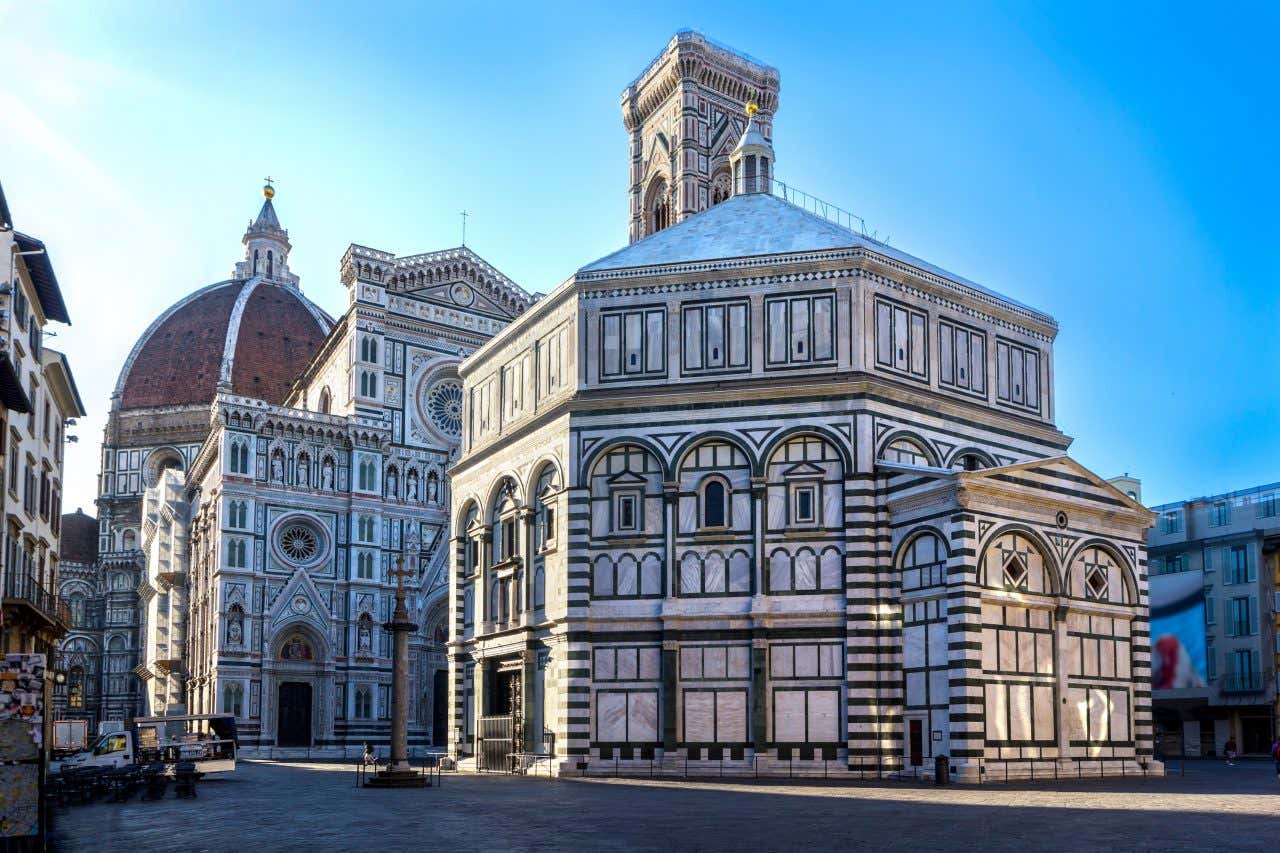
The Florence Baptistery’s main feature is its three monumental sets of bronze doors that represent Biblical scenes differently: the North doors, South doors, and East doors. Considered a Renaissance masterpiece, the East doors or “Gates of Paradise” are the most famous. These doors consist of ten panels illustrating stories from the Old Testament with intricate three-dimensional details. Michelangelo once said that they were so beautiful “they might fittingly stand at the gates of Paradise.” Stunning!
However, the original “Gates of Paradise” are no longer at the Florence Baptistery, as they were moved for preservation. You can find the original works of art created for the Florence Cathedral, the Florence Baptistery, and Giotto’s Campanile in the Museo dell’Opera del Duomo. To visit the Florence Baptistery and admire its original bronze doors, we recommend you check out this guided tour of the Florence Baptistery and the Museo dell’Opera del Duomo.
5. Dive into the History of the Palazzo Vecchio
As one of the city’s most iconic landmarks, the Palazzo Vecchio is rich in history, art, and political significance. This medieval fortress-palace has been the center of Florence’s government for centuries and was originally designed as the seat of the Florentine Republic. Today, it houses the city’s town hall and is also a museum open to visitors. It was first called the Palazzo della Signoria but became the Palazzo Vecchio during the Medici rule after Cosimo I de’ Medici moved his residence to Palazzo Pitti.
From the exterior, you can admire the Torre d’Arnolfo, standing at 308 feet (94 meters) tall. Inside, you can find three courtyards and a fascinating room with ancient maps and a large globe. You’ll also find luxurious rooms decorated with Renaissance art, including works by Michelangelo and Donatello. The Salone dei Cinquecento (“Hall of the Five Hundred”) is the palace’s main highlight, a stunning hall with large frescoes by Vasari depicting the victories of the Medici family.
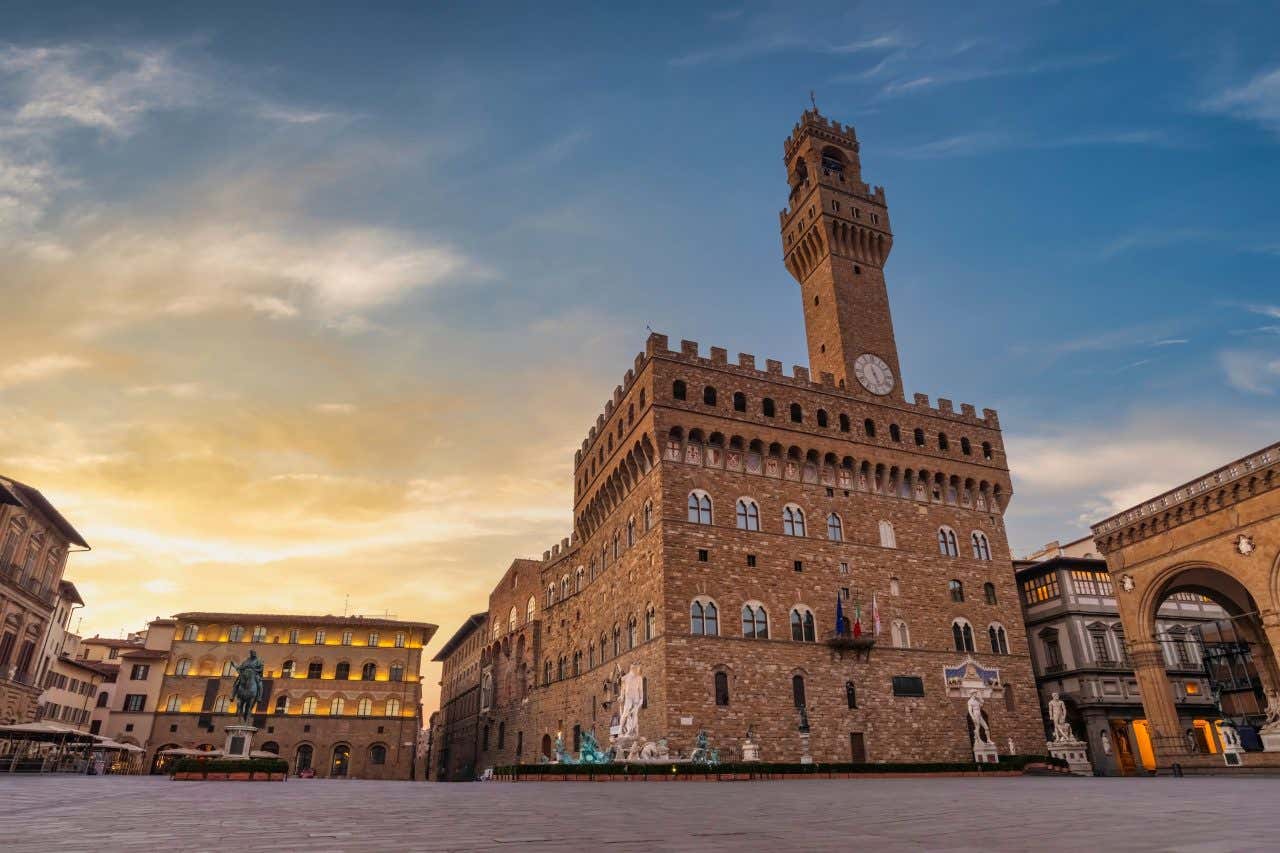
But that’s not all—the Palazzo Vecchio also has secret passages! These mysterious passages were used by the Medici family to move discreetly and store documents and valuables. Are you curious about diving into the legends and myths of this iconic site? Wind through a labyrinth of hidden doors and corridors by joining this Palazzo Vecchio secret passages tour! We also suggest you check out this guided tour of the Palazzo Vecchio to explore its rooms and learn about its fascinating history.
6. Shop for Jewelry at the Ponte Vecchio
Did you know the Ponte Vecchio is the only bridge in Florence spared from destruction during World War II? The Ponte Vecchio, which means “Old Bridge,” is a medieval stone bridge with three arches spanning the Arno River. This famous bridge is considered a national artistic heritage and is very close to the Uffizi Gallery. Above the bridge, you’ll find the Vasari Corridor, an elevated passageway that was used by the Medici family to move safely between Palazzo Vecchio and Palazzo Pitti without mingling with commoners.
Unlike most bridges, the Ponte Vecchio is famous for its shops along both sides. In the past, the shops were owned by butchers, tanners, and farmers, but nowadays, you’ll find goldsmiths, jewelers, art dealers, and souvenir sellers. This is because, in 1565, the Medici family ordered the butchers to be replaced to improve the bridge’s image. Admire the city center and main attractions while pedaling past the Ponte Vecchio with this bicycle tour of Florence! It’s best to visit at sunset, as it’s a great place to take pictures of the views of the Arno. Don’t miss stopping at the Ponte Vecchio, especially if you’re looking to shop for fine jewelry!
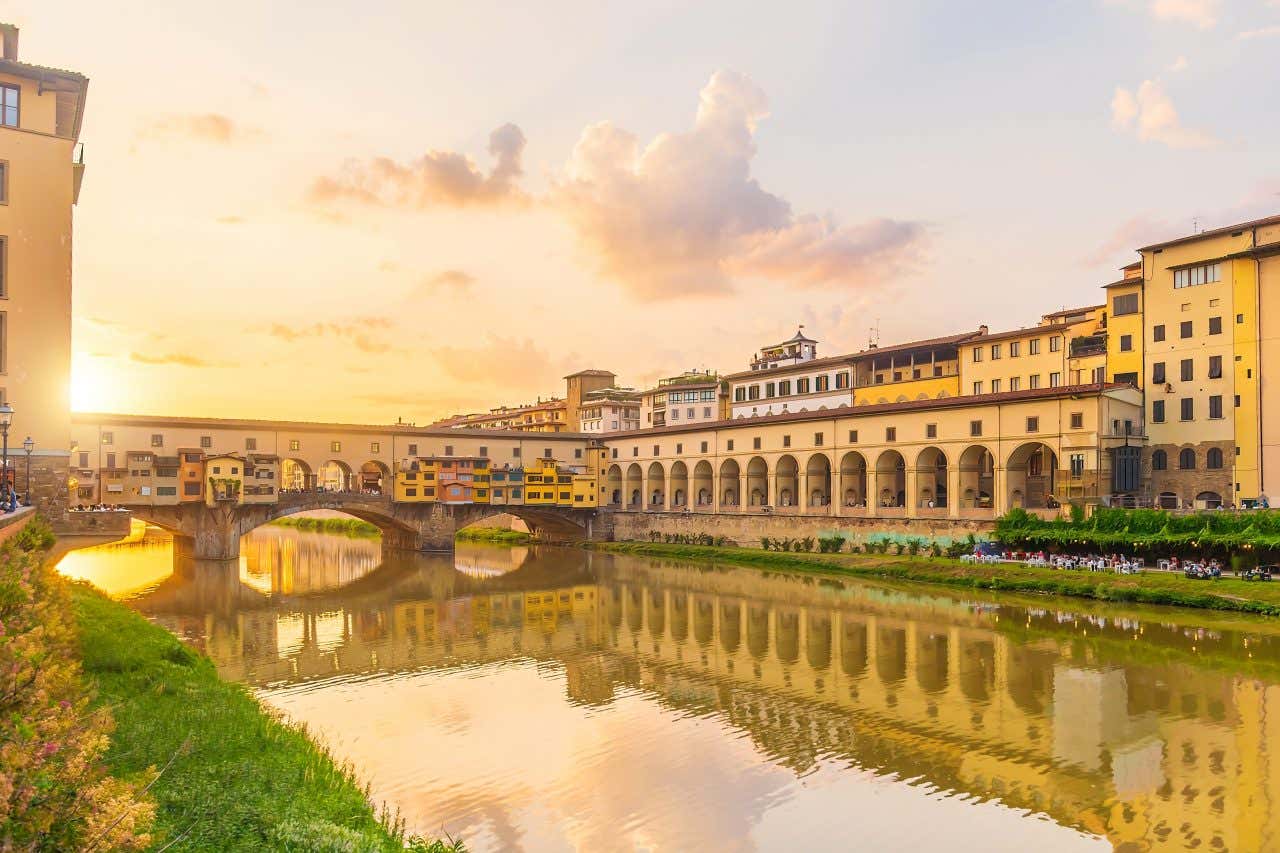
7. Explore the Rooms of the Palazzo Pitti
Calling all art lovers! In the Oltrarno district, just a 5-minute walk away from the Ponte Vecchio, you’ll find the Palazzo Pitti, a massive Renaissance palace sitting on the south side of the Arno. This palace was originally built for Luca Pitti, a wealthy Florentine banker who wanted a residence to rival the Medici. It was later acquired by the Medici to become the official residence of the Grand Duchy of Tuscany. The Palazzo Pitti has expanded over the centuries and was even used as a base by Napoleon. It’s a true symbol of power and prestige!
Inside Palazzo Pitti, you’ll discover the impressive Palatine Gallery, with masterpieces by Raphael, Caravaggio, and more artists. The palace also houses the Gallery of Modern Art, featuring 19th and early 20th-century Italian paintings. In the Treasury of the Grand Dukes, you can admire a remarkable collection of jewelry, silverware, and precious objects from the Medici and Habsburg families. The Museum of Costumes and Fashion, showcasing centuries of Italian fashion and court attire, is perfect if you’re a fashionista! All of these attractions are housed within Palazzo Pitti, making it the largest museum complex in Florence.
Why not enjoy a guided tour of the Palazzo Pitti and the Palatine Gallery? You’ll have the chance to discover the rich history of this magnificent palace and immerse yourself in its art. Plus, you won’t have to wait in line!
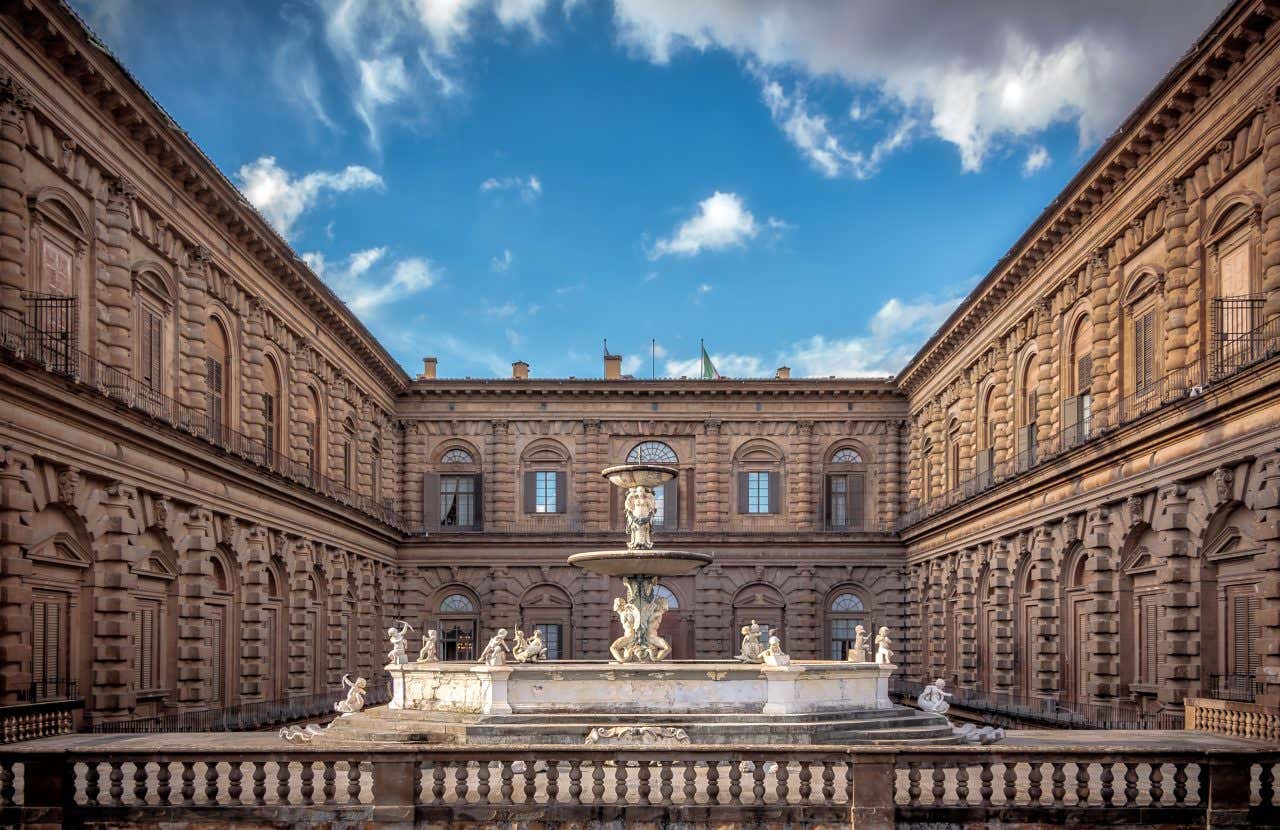
8. Stroll Through the Beautiful Boboli Gardens
Right behind the Palazzo Pitti lies the Boboli Gardens, the largest and most beautiful Renaissance garden in Italy. This historical park was added to the palace estate by the Medici and was later opened to the public. These gardens are a prime example of an authentic Italian garden, which later served as inspiration for many European courts. Scattered throughout the garden, you’ll find statues of many styles and periods of gods, mythological figures, and important historical characters. You’ll also admire impressive fountains, including the Fountain of Neptune and the Fountain of the Ocean, along with artificial caves.
As you stroll through the stunning pathways in the Boboli Gardens, you’ll come across its amphitheater, adorned with Roman statues and the Ancient Egyptian Boboli obelisk at the center. Here, you can also see the Porcelain Museum and the Kunsthistorisches Museum, displaying art and decorative pieces. Visit the Boboli Gardens if you’re looking to escape the bustling city and enjoy a peaceful walk or a picnic. You’ll love this beautiful UNESCO World Heritage Site.
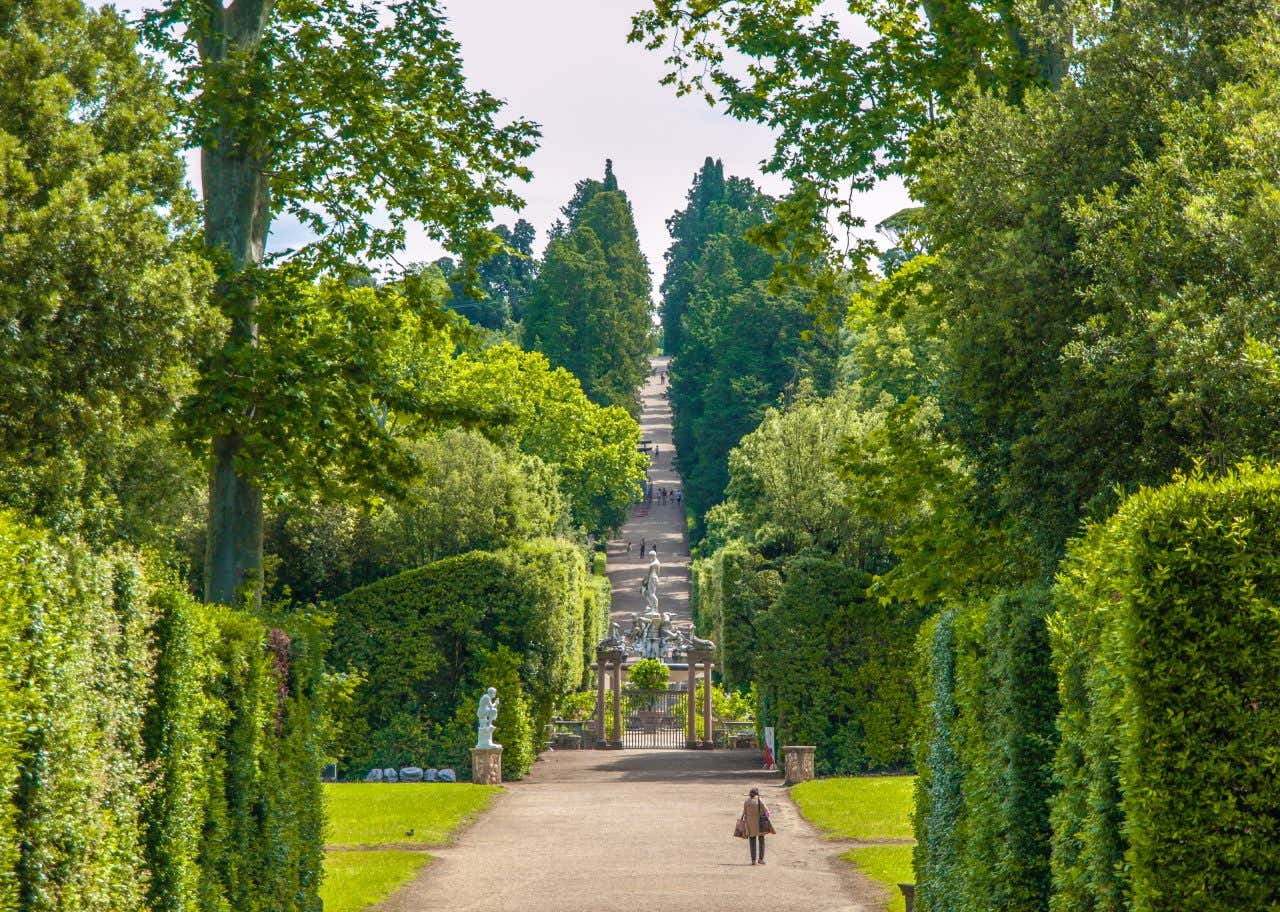
9. Admire the Art of the Galleria dell’Accademia di Firenze
Another famous museum in Florence is the Galleria dell’Accademia di Firenze, just a short walk from the Florence Cathedral. It was founded in 1784 as part of the Academy of Fine Arts and was originally intended to provide students with artistic inspiration through masterpieces. This museum is smaller and more specialized than the Uffizi Gallery, Florence’s main art museum, yet it’s Italy’s second-most visited art museum.
The star of the Galleria dell’Accademia di Firenze is Michelangelo’s David, a breathtaking 17-foot-tall (5.17 meters) marble sculpture of the biblical hero before his battle with Goliath. Prepare to be mesmerized by its flawless anatomy and expressive detail!
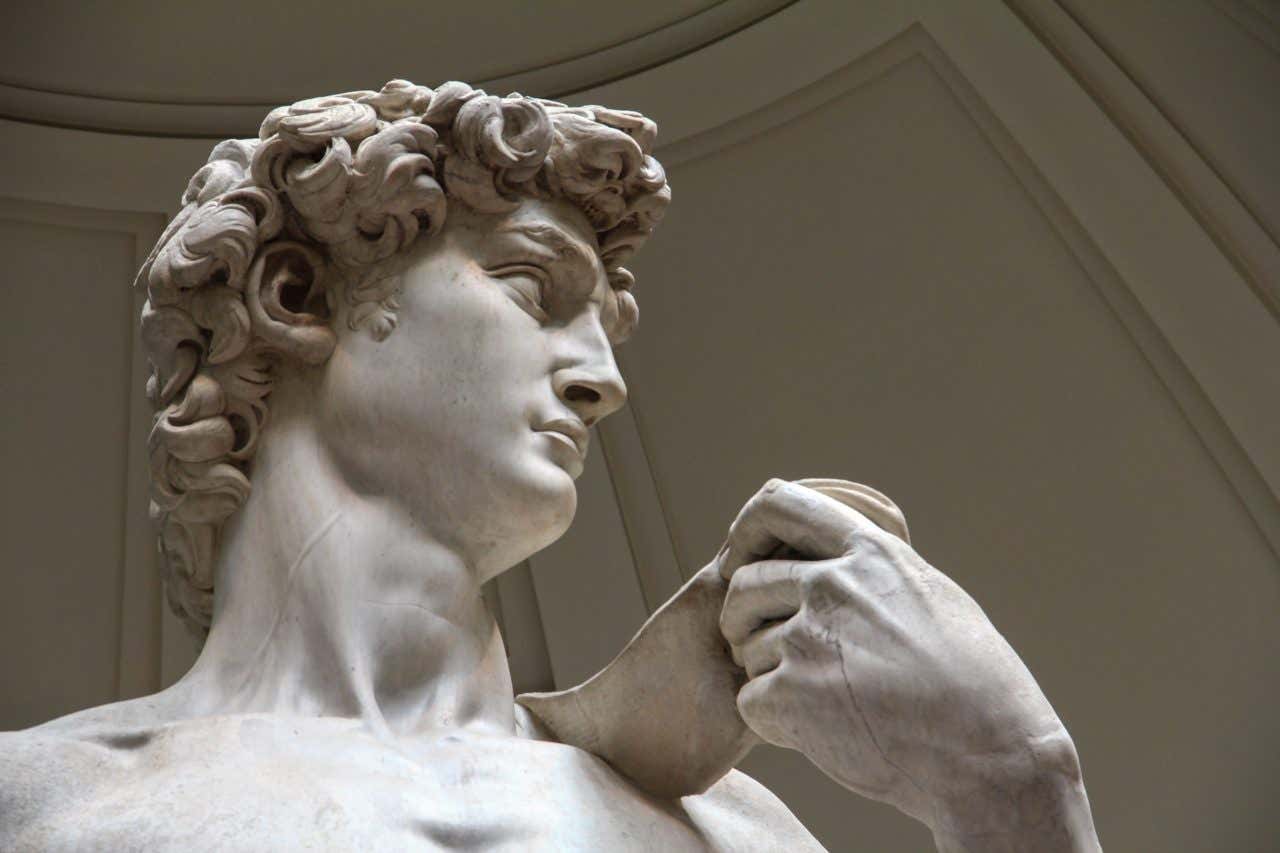
The gallery is also home to Giambologna’s masterpiece Abduction of a Sabine Woman and Prisoners, four unfinished sculptures by Michelangelo. You can also admire a collection of 13th-16th century Florentine paintings, Russian icons assembled by the Grand Dukes of the House of Lorraine, and the Museo degli strumenti musicali (Museum of Musical Instruments), filled with historic rare instruments.
To marvel at Renaissance masterpieces and David up close, you can visit the Galleria dell’Accademia di Firenze on a guided tour. If you’re passionate about art and history, you can’t miss stopping at this museum.
10. Tour the Basilica di Santa Croce
The city of Florence houses the largest Franciscan church in the world, the Basilica di Santa Croce, Italian for “Basilica of the Holy Cross.” Completed in the 19th century, this Gothic-style basilica’s exterior is adorned with a striking facade of white, green, and pink marble. Inside, you’ll find artwork from many Italian artists. However, its most notable feature is its sixteen chapels, many decorated with frescoes by Giotto and his pupils. It’s located in the historic center of Florence, making it easily accessible from other attractions like the Uffizi Gallery.
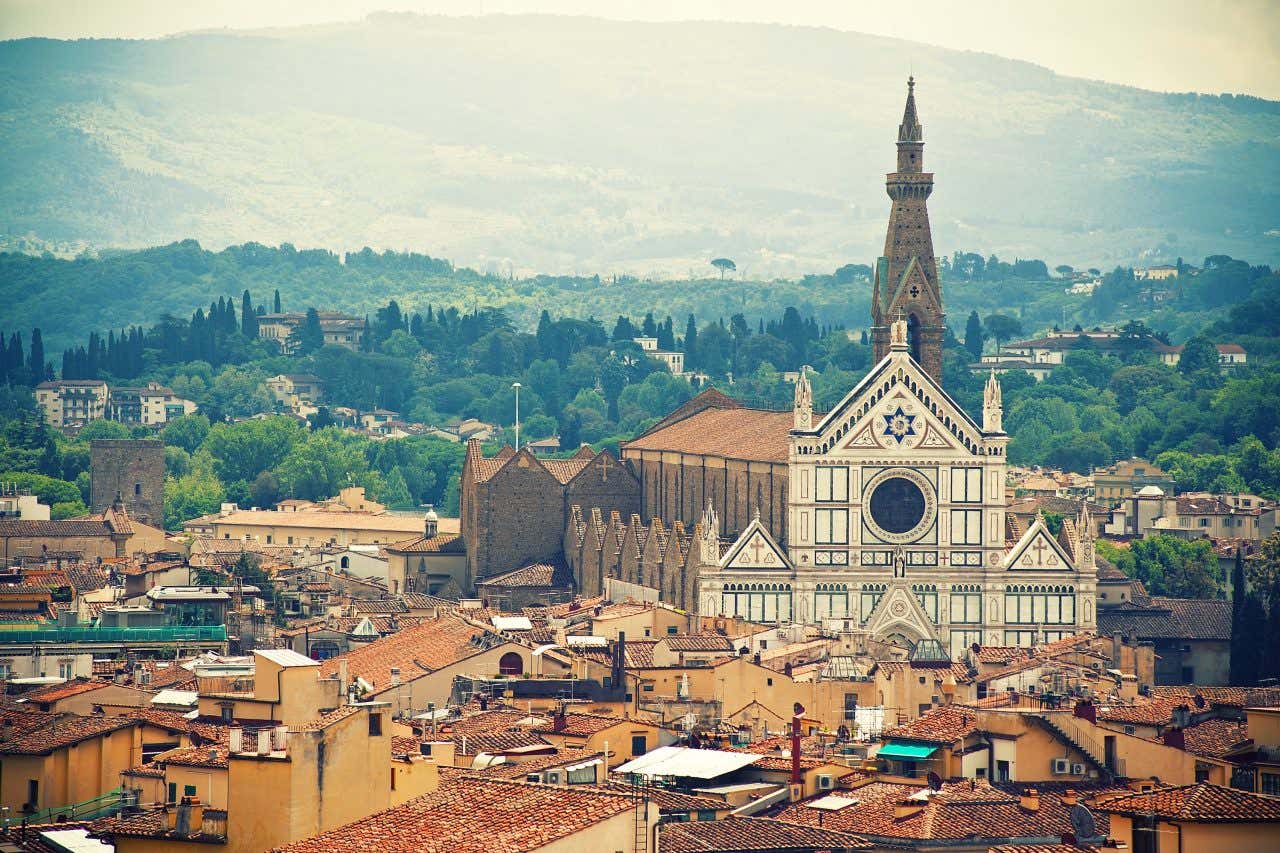
Did you know it’s also known as the Temple of the Italian Glories? This name comes from the fact that many notable Italians are buried here. You can find the tombs of artists Leonardo da Vinci and Michelangelo, the father of modern physics and astronomy Galilei, political philosopher and writer Machiavelli, composer Rossini, and many more. It also features a cenotaph dedicated to the famous poet and author of The Divine Comedy Dante Alighieri.
Interested in touring this impressive church? We suggest you check out this guided tour of the Basilica di Santa Croce to learn all about its artistic and cultural significance.
11. Enjoy Florentine Cuisine at the Mercato Centrale
Of course, no trip to Florence would be complete without diving into Florence’s cuisine! The Mercato Centrale is one of the best places to experience Florentine culture and daily life. This vibrant market is filled with fresh products, Tuscan specialties, and plenty of restaurants for a fantastic dining experience. It’s found inside a beautiful iron and glass structure. Outside, you’ll see the Mercato di San Lorenzo (San Lorenzo Market), which sells leather goods, souvenirs, and clothing. It was designed by the same architect behind Milan’s Galleria Vittorio Emanuele II, Giuseppe Mengoni, during the risanamento time, the late 19th-century period when Florence was Italy’s capital.
Meat, seafood, fresh pasta and bread, Italian cheeses, truffles, olive oil, balsamic vinegar, fresh fruits and vegetables…you can find all of these ingredients of Tuscan cuisine in the Mercato Centrale! The market’s first floor was later transformed into a gourmet food court. It’s an ideal place to savor traditional Tuscan dishes like ribollita (bread and vegetable soup), lampredotto (tripe sandwich), pizza, pasta, and Florentine steak. For dessert, you can indulge in a delicious gelato or a cantucci (almond biscotti)! You can also enjoy an exquisite glass of wine or beer at the wine bars and craft beer spots. It’s the perfect place for foodies!

Speaking of delicious food and fine wine, why not join a food tour of Florence? You’ll stop at local restaurants and taste traditional Tuscan products. If you’re a wine aficionado, you can discover one of Italy’s most famous winemaking regions with a tour of the Chianti area. You’ll have the chance to walk through vineyards, visit a winery, and enjoy a wine tasting!
12. Experience the Leonardo da Vinci Museum
Just 5 minutes away from the Uffizi Gallery lies the Leonardo da Vinci Museum. This museum showcases Leonardo da Vinci’s contributions not only as an artist but also as an inventor, scientist, and engineer. Here, you can see original manuscripts and drawings, as well as reproductions of his most famous sketches, like the Vitruvian Man. You’ll also find over 50 interactive models and working replicas of his inventions, such as war machines, hydraulic pumps, and flying machines! It also includes some of Leonardo’s iconic paintings and detailed explanations of his artistic techniques, along with workshops and activities.
Interested in discovering the life and legacy of Leonardo da Vinci? We recommend you join this walking tour of Florence, where you’ll learn about Leonardo da Vinci’s life and legacy and see the places where he lived and worked. If you want to explore Leonardo’s scientific and artistic endeavors in-depth, don’t forget to book this ticket to the Leonardo Museum! It’s a great plan for visitors of all ages!
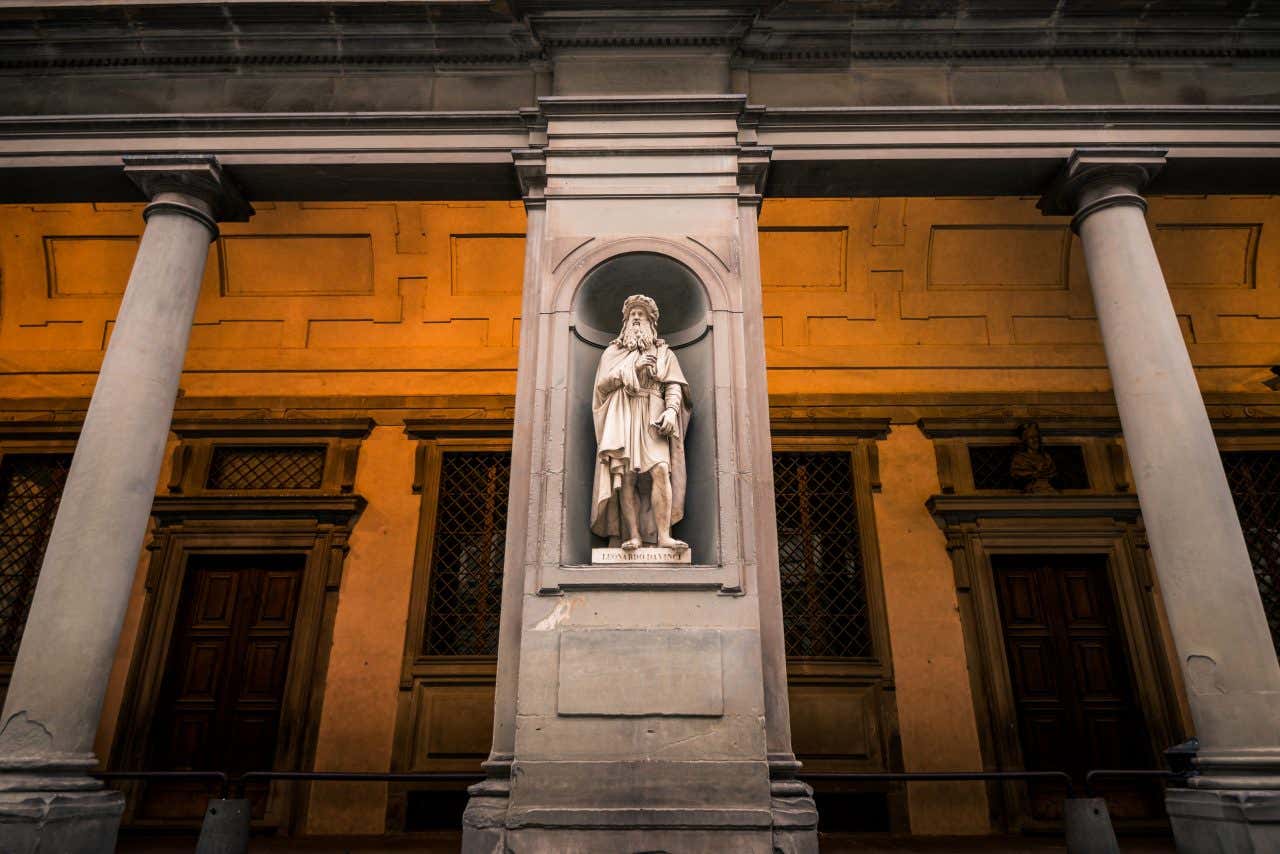
A short walk from the Leonardo da Vinci Museum is the Museo Galileo, dedicated to renowned astronomer and scientist Galileo Galilei. Home to the world’s largest collection of scientific instruments, this museum shows the crucial role that the Medici family and the Lorraine Grand Dukes played in advancing science and supporting scientists. It has a library with approximately 150,000 works about the history of science, a multimedia lab, and temporary exhibitions of science and discoveries. In the Medici and Lorraine Collections, you’ll see artifacts gathered by both the Medici and Lorraine dynasties. Without a doubt, both of these popular museums are ideal places to unleash your curiosity.
13. Unwind with a Boat Ride Along the Arno
Stretching approximately 150 miles (241 kilometers) and flowing through several Italian towns, the Arno is the second-largest river in Tuscany. It has been an important waterway in history for trade and transportation. The Arno is lined with historic bridges, but the most famous is the Ponte Vecchio, known for its shops and stunning views.
This river is a popular spot for strolling, cycling, and even enjoying a boat ride! If you join this free walking tour of Florence, you’ll be able to see the Tuscan capital, walk along the Arno, and see the city’s iconic sites. Or, you can explore the city differently with a boat tour along the Arno. You’ll love gliding along the river while admiring Florence’s beautiful riverside sights in an authentic Florentine gondola!
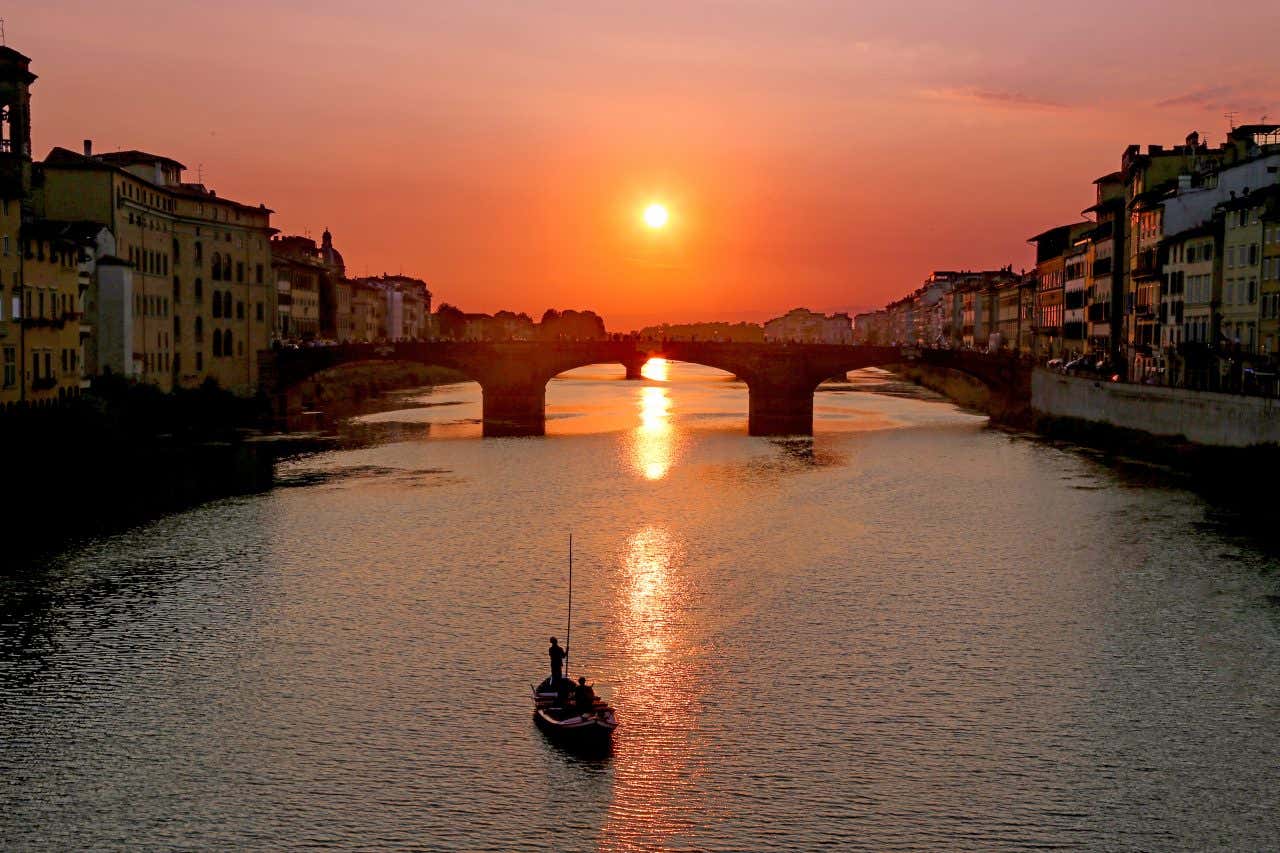
Day Trips from Florence
Have some extra time and itching to explore the charming towns and cities surrounding Florence? You’re in luck, as many day trips depart from the Tuscan capital! Whether you’re keen to immerse yourself into the ancient history of Pompeii, explore the “Floating City” of Venice, marvel at the iconic Leaning Tower of Pisa, or indulge in world-famous gelato in the hilltop town of San Gimignano, we’ve got you covered. Here at Civitatis, we’ve selected our favorite day trips from Florence:
- Day trip to Pisa, San Gimignano, and Siena
- Day trip to Venice
- Day trip to Pompeii by train
- Day trip to Pisa and Lucca
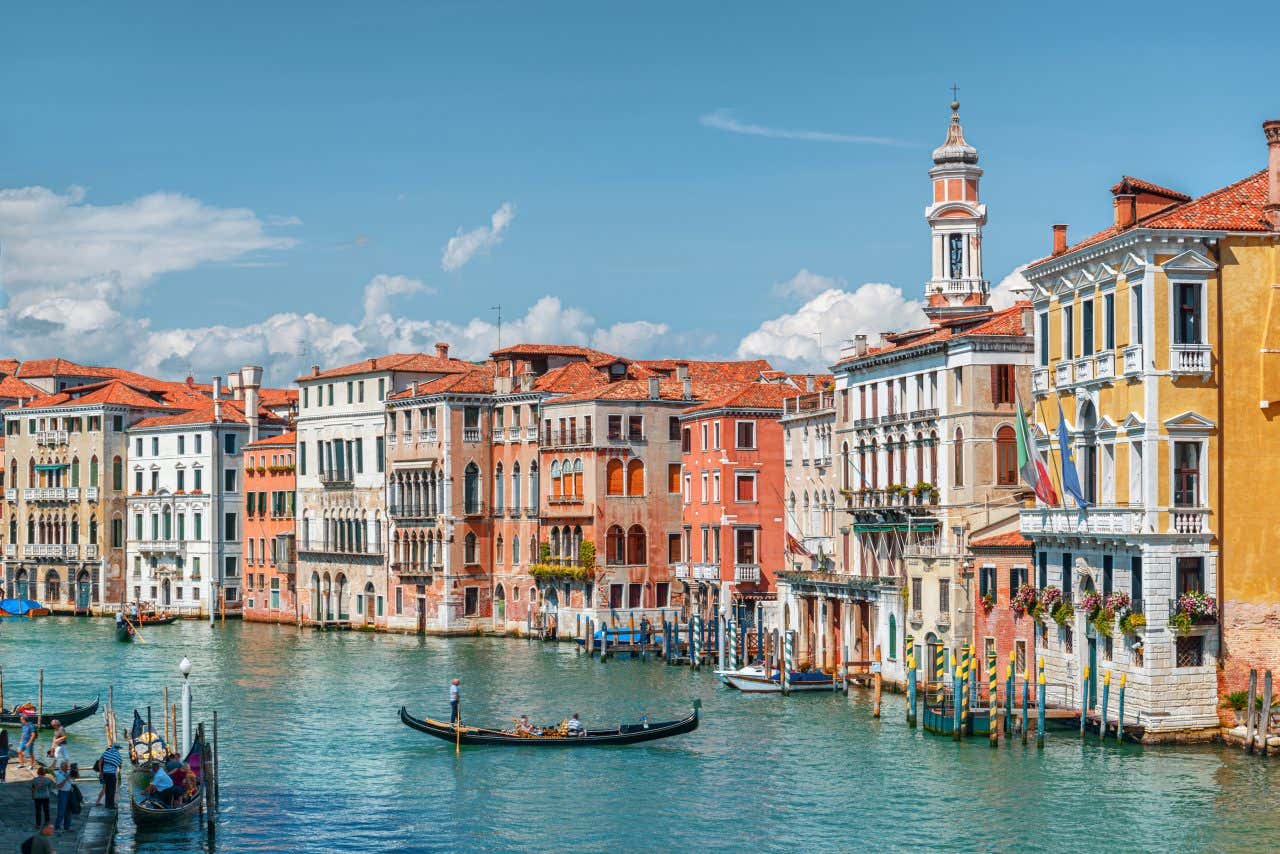
There you have it! Those are some of our favorite things to do in the capital of the Tuscany region! From the vibrant atmosphere of the Ponte Vecchio to the lush Boboli Gardens, Florence is filled with charming streets and art on every corner. With its rich history, breathtaking art, and delicious cuisine, you’re sure to fall in love with this city. For even more plans, check out more activities, tours, and day trips in Florence with Civitatis. What are you waiting for? Pack your bags and get ready for an unforgettable experience in Florence! Until next time, arrivederci!






